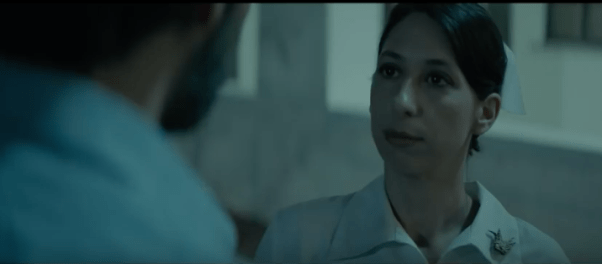One academic’s emotional journey of awakening is told in the new film, Un Traductor
By Linda Pentz Gunter
Sitting crammed on a transatlantic flight, drinking weak coffee and picking at a lamentable apology for pasta is not where one would expect to find oneself watching a remarkable film about Chernobyl. But that is what happened recently.
Un Traductor (A Translator), released this year, tells the true story of a Cuban professor of Russian literature who, in 1989, abruptly finds his lessons canceled and a note on the university door directing him to the local hospital in Havana. There, he is told he must serve as a translator. But for whom? “The patients from Chernobyl” replies an emotionless senior nurse. The film is directed by Cuban brothers, Sebastián and Rodrigo Barriuso.
Malin (we never learn his last name until the credits) finds himself serving as interpreter at night on a children’s ward filled with victims from the 1986 Chernobyl nuclear disaster in Ukraine. At first, his only task is to inform parents that their child is fundamentally terminal. Devastated, he immediately wants out and to return to his comfortable home life with his wife and his own young son. “You chose to be a nurse!” he rails at Gladys, the matter-of-fact night nurse with whom he works and who has escaped the juntas of her native Argentina to work in Cuban’s renowned medical field. “I didn’t choose any of this,” he insists.
“These kids didn’t choose either,” she retorts.
Gradually, however, Malin becomes ever more invested in the young patients, and beyond translating, he reads them stories and has them write their own, or draw pictures of their experiences, their hopes, and about who they are.
The film does a powerful and moving job of communicating just what nuclear technology can do to children if it goes wrong, as it did in Chernobyl, whose explosion spewed radiation densely across Belarus and parts of Russia and Ukraine, with the plume spreading over Europe and eventually touching the U.S.

Genadijs Dolganovs delivers a moving performance as a stricken parent.
It is hard to watch this film and not ask why anyone would support an industry that harms children in this way — and inflicts such agonizing grief on their parents. Malin befriends one particular boy, Alexei, who is in isolation from the other children due to his compromised immune system, and superbly played by Nikita Semenov. At one point, the boy’s father (movingly played by Genadijs Dolganovs, also in The Shape of Water), describes the irony of radiation now being used to treat his child’s cancer after having caused it in the first place. “How much radiation do you think one body can take?” he asks Malin.
Dolganovs, a Canada-based Latvian actor, has few scenes in the film but he owns every one. He describes with bitter and regretful pride how honored he had felt to be invited to Pripyat as the high school science teacher for the children of the eminent scientists working at the Chernobyl nuclear power plant.
Brazilian actor Rodrigo Santoro is mesmerizing as Malin, delivering a quiet, intimate portrait of a man suddenly shaken awake, forced to confront a level of pain he had clearly never given much thought to. (His performance is all the more impressive in that he had to learn the Russian and Spanish lines phonetically without knowing either language.)
There are also two great performances by the leading women in the film — Maricel Álvarez as Gladys and Yoandra Suárez as Malin’s long-suffering and, at first, detached wife, who sees him drifting away from his own family the more absorbed he becomes with the Chernobyl children. She focuses on her job arranging art exhibitions, on their young son Javi, and on her pregnancy, temporarily moving away but eventually reconciling with Malin.

Maricel Álvarez as the Argentinian nurse, Gladys, provides the emotional anchor to the film.
Gladys serves as the emotional center of the film, maintaining a stern exterior to suppress her inner turmoil, committed, constantly drawing Malin back to the work he finds so desperately painful. As Malin’s marriage begins to crumble, one wonders whether a romance between them will blossom. Whether loyal to the biographical truth, or simply to avoid Hollywood cliché, the screenwriter, Lindsay Gossling, thankfully does not go there.

Ultimately, the film follows Malin’s gradual awakening to the harsh realities of the world beyond his comfortable job and home life. When petrol shortages mean Malin can no longer drive, he takes to his bicycle, from which he is thrown one rainy evening on his way to the hospital, limping in battered and bloodied as he desperately tries to get to Alexi’s side in time for the boy’s latest treatment.
The end of the film includes a fascinating reveal about the origins of the film, which is shot almost entirely in Havana, likely little changed since the 1980s. And while it touches on the political shifts as Gorbachev moves away from Soviet communism, its main message is humanitarian. It is a touching, important piece of filmmaking that conveys all too directly just how painful, tragic and ultimately unacceptable, the risk of using nuclear power really is.
Un Traductor is available for rent or purchase from iTunes and Amazon Prime.
Watch an interview with lead actor, Rodrigo Santoro, and the directors, Sebastián and Rodrigo Barriuso, below.
Headline photo taken from the trailer of Un Traductor.
 Beyond Nuclear International
Beyond Nuclear International